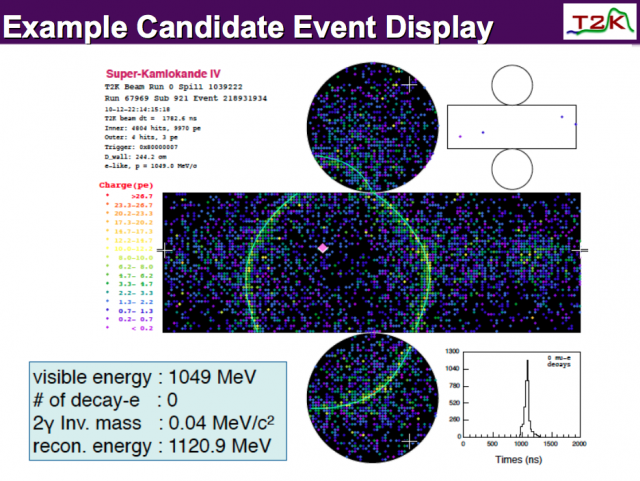
Example of νe appearance: T2K beam event in SK.
Recently published results from T2K have made a step towards a possible answer to one of the biggest unsolved problems in physics: why do we see only matter in the present-day Universe when equal amounts of matter and antimatter were created in the Big Bang?
The T2K results may lead the way to new studies of a known matter/anti-matter asymmetry called charge-parity (CP) symmetry violation. Nobel prizes were awarded in 1980 and 2008 for observations of this phenomenon in quarks, the fundamental particles that make up the nucleons in atomic nuclei, but not in neutrinos. CP violation in the early universe may be the reason that the observable universe today is dominated by matter with no significant anti-matter. The search for CP violation in neutrinos is likely to be a major scientific quest in the coming years.
Neutrinos are subatomic particles with no electric charge, and the smallest mass of all known particles (a million times smaller than the mass of the electron). Neutrinos come in three types, or “flavors”; electron, muon, and tau. As they travel, neutrinos can oscillate from one flavor to another (see About Neutrinos for more details). In June 2011, T2K announced the first-ever observations of the transformation or “oscillation” of muon neutrinos into electron neutrinos.
In the T2K experiment in Japan, a muon neutrino beam is produced using the high intensity proton accelerator at the Japan Proton Accelerator Research Complex (J-PARC), located in Tokai, Ibaraki Prefecture, on the east coast of Japan, about 100 km NE of Tokyo. The neutrino beam was aimed at the Super-Kamiokande (SK) underground detector in Kamioka, Gifu Prefecture, near the west coast of Japan, 295 km (185 miles) away from Tokai (see About T2K for more details).
The flux of muon and electron neutrinos measured in SK are compared with expected flux without oscillation. T2K scientists were able to identify 6 electron neutrino events, while the estimated number of background events is 1.5. This new result is the first measurement of “electron neutrino appearance” from a muon neutrino beam: muon neutrinos “oscillating” into electron neutrinos.
This is a hard measurement to make for two reasons: the probability of the oscillation process occurring is much smaller than mu to tau oscillations, and there are a variety of other, more abundant processes producing events in SK that can be mistaken for electron neutrinos from the beam. In other words, since very few electron appearance events are expected, even with the high-intensity J-PARC beam, mistaken identification of background events becomes a substantial hazard.
Previous experiments had reported only upper limits on the probability of electron neutrino appearance, that is, no statistically significant excess of detected events over estimated background. Thus, the T2K result for the first time provides statistically significant indications of appearance. These results were peer-reviewed and published in Physical Review Letters, which is widely recognized as one of the highest-impact international physics journals.
Further steps towards the goal of understanding CP violation and other neutrino physics phenomena will continue to require large global scientific collaborations, like T2K, to overcome the significant technical challenges in this search. More data are required to confirm that these oscillations are occurring, and make our measurements of the physical quantities involved more precise.
T2K will acquire these data during the next few years. For the time being, accelerator operations are on hold until the Japanese national electric power system recovers from losses of generating capacity following the earthquake and tsunami in March, 2011, but we hope to restart operations in early 2012. After these initial results are confirmed, T2K will go on to investigate the matter/antimatter problem by taking data with a muon antineutrino beam, and comparing antineutrino oscillations with neutrino oscillations.
See also: other pages on this website: The T2K experiment, About neutrinos
Related Links:
T2K press releases, issued in Japan, and the USA.
Articles in the Los Angeles Times Neutrino observation a step toward understanding the Big Bang
and Nature Blogs Neutrino experiments could test matter-antimatter symmetry
Viewpoint: A new neutrino oscillation , Stephen J. Parke, Physics 4, 57 (2011) – Published July 18, 2011.
Scientific paper (accepted for publication in Physical Review Letters): Indication of Electron Neutrino Appearance from an Accelerator-produced Off-axis Muon Neutrino Beam :

The title of the appearance paper as it appeared in Physical Review Letters



